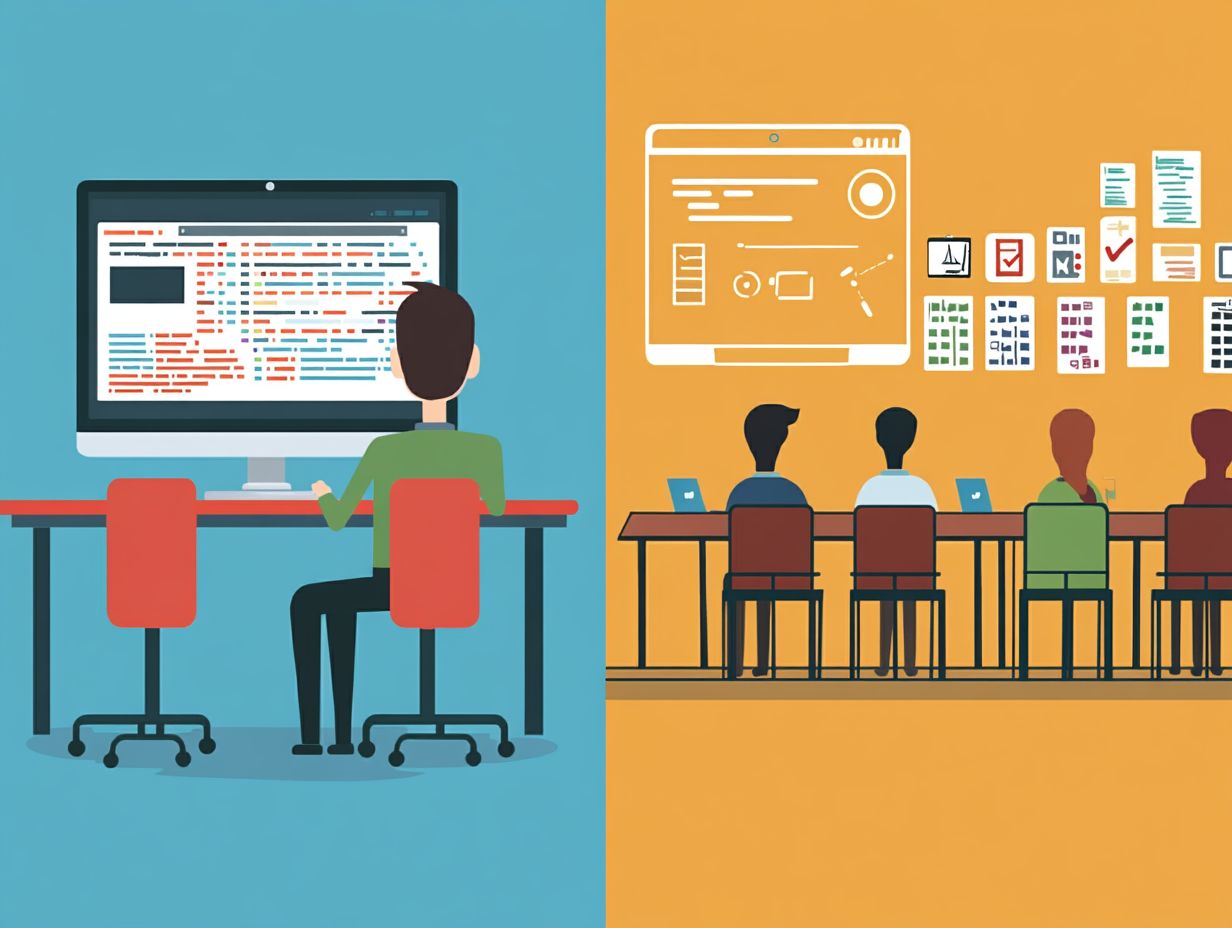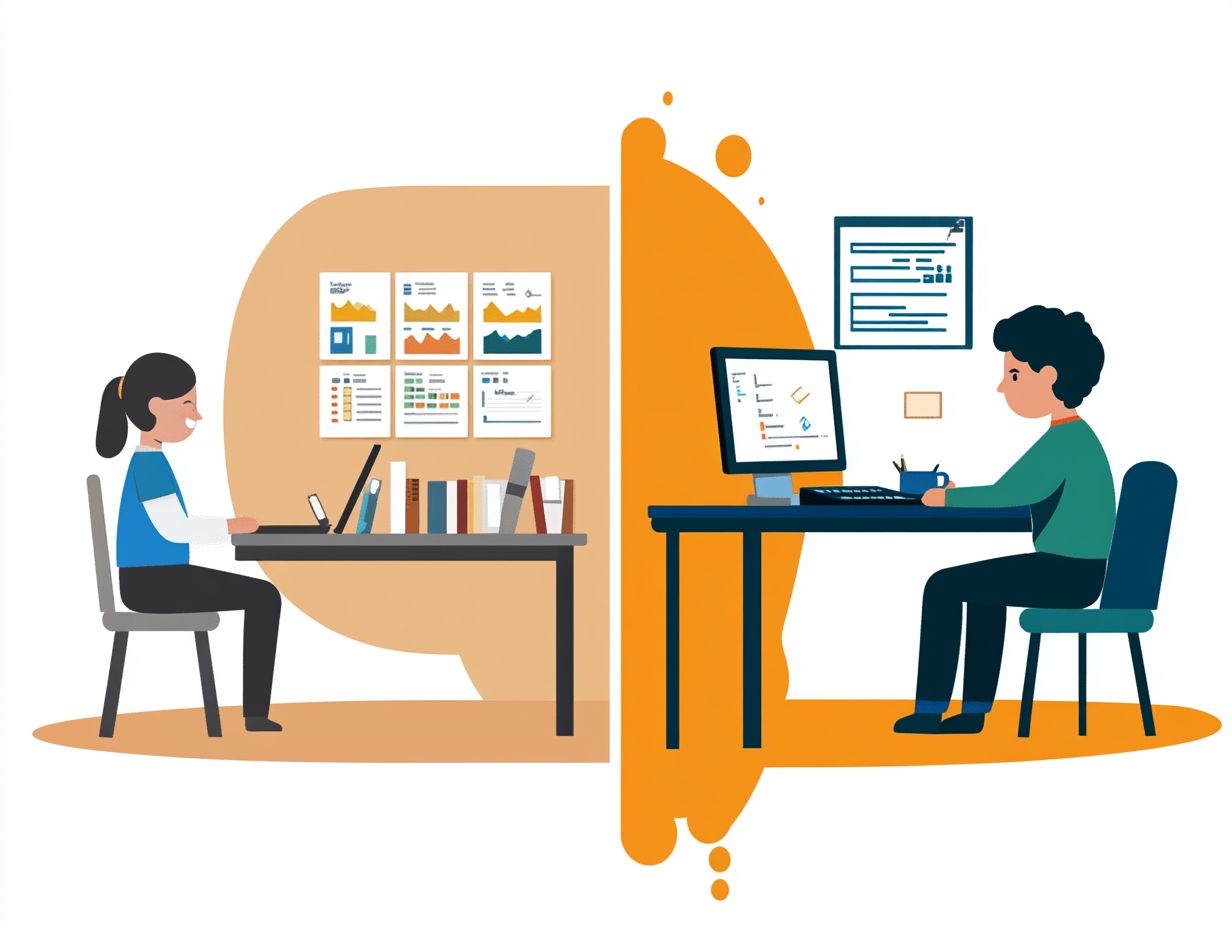E-Learning vs. Traditional Training: A Comparison
In today s fast-paced world, selecting the right training method can significantly influence your learning outcomes and career path.
E-learning and traditional training both bring distinct advantages to the table. E-learning offers flexibility and cost-effectiveness, while traditional training provides hands-on experiences and personalized instruction.
Get ready to explore the unique benefits of both training methods as this article compares their effectiveness and engagement levels.
By grasping the strengths of each method, you can make a well-informed choice about the training approach that best aligns with your needs.
Contents
- Key Takeaways:
- Benefits of E-Learning
- Benefits of Traditional Training
- Comparison of E-Learning and Traditional Training
- Choosing the Right Training Method
- Frequently Asked Questions
- What is E-Learning?
- Which method is more cost-effective: E-Learning or Traditional Training?
- Are there any differences in the learning experience between E-Learning and Traditional Training?
- Can E-Learning and Traditional Training be combined for a more effective learning experience?
- Which method is more suitable for hands-on or practical training?
- How do employers decide whether to use E-Learning or Traditional Training for their employees?
Key Takeaways:

- E-learning offers flexibility and accessibility for learners, allowing them to access materials and complete training at their own pace and convenience.
- Traditional training provides hands-on learning and personalized instruction, leading to a more interactive and tailored experience.
- When choosing a training method, consider the effectiveness and efficiency of e-learning, along with the engagement and retention rates seen in traditional training.
Defining E-Learning and Traditional Training
E-learning offers a transformative approach to education by using digital tools to create engaging and accessible learning environments that surpass traditional training methods.
Unlike conventional classrooms, which often use a one-size-fits-all curriculum and restrict interaction, e-learning leverages technology to deliver personalized learning experiences. With software that helps you manage your classes and track your progress, you can access a wealth of resources and receive immediate feedback tailored to your journey.
Incorporating methods like peer-to-peer learning and practical exercises enhances knowledge retention and application. This dynamic interaction fosters a sense of community among learners and facilitates real-world problem-solving. Ultimately, this approach yields effective learning outcomes finely tuned to your individual needs.
Benefits of E-Learning
E-learning presents a multitude of advantages tailored to meet the diverse needs of learners, especially in today s fast-paced environment where flexibility and accessibility are essential.
By using digital platforms, you can access a wide range of online courses whenever it suits you. This feature is invaluable for those juggling job responsibilities or pursuing education alongside other commitments.
The integration of synchronous and asynchronous elements in blended learning approaches not only elevates engagement but also enhances knowledge retention, making it an ideal solution for a hybrid workforce.
Flexibility and Accessibility
One of the standout features of e-learning is its remarkable flexibility. It allows you to engage with educational materials at your own pace and convenience an essential benefit for students and professionals alike.
This adaptability is crucial when juggling a job and education since traditional brick-and-mortar classes often fail to fit around your work hours. For instance, as a single parent, you can manage your learning while tending to your child’s needs, accessing lectures late at night when it suits you best.
Methodologies like microlearning and gamification deliver bite-sized content tailored to your preferences. Even with a busy lifestyle, you remain engaged. The inclusion of interactive elements, such as quizzes and discussion forums, keeps you motivated and involved, showcasing the transformative power of e-learning in making education more accessible and inclusive for everyone.
In summary, consider your unique needs and preferences when evaluating training methods. Choose the one that enhances your learning journey most effectively.
Cost-Effectiveness
E-learning is not just a flexible and accessible option for you; it also stands out as a significantly more cost-effective solution compared to traditional training methods. By cutting out the need for physical classrooms and materials, your organization can trim down expenses related to travel, facility rentals, and printed educational resources. You can deliver high-quality online courses tailored to various learning needs. This efficiency is crucial in healthcare, where training costs can increase rapidly.
With e-learning platforms, you gain the ability to rapidly scale your training efforts, allowing you to reach more employees without proportionally increasing costs. For instance, if your software company invests in traditional seminars, you may face hefty expenses for hiring instructors and securing facilities. However, by shifting to virtual training modules, you can educate hundreds of employees simultaneously at a fraction of the original cost.
E-learning provides ongoing access to materials, enabling employees to revisit content as needed. This not only enhances retention but also reduces the necessity for retraining, ultimately leading to long-term savings for your organization.
Benefits of Traditional Training

Despite the surge of e-learning, traditional training still holds invaluable benefits that make it critical in certain contexts, especially when it comes to hands-on learning experiences that demand direct interaction and instant feedback.
One of the standout advantages of traditional training is tailored teaching. This format allows educators and trainers to engage directly with you, customizing their methods to suit your specific needs. It creates an environment that promotes effective employee onboarding and skill development.
The face-to-face dynamic not only fosters deeper relationships but also enriches your learning journey through real-time assessments and the ability to adapt on the fly.
Hands-On Learning Experience
Hands-on learning stands as a cornerstone of traditional training, granting you the invaluable opportunity to engage directly with the materials, tools, and techniques essential for mastering new skills and job roles. This practical approach deepens your conceptual understanding through real-world applications, making it particularly effective in fields that demand specific competencies, like healthcare or technical professions.
The immediate feedback provided in traditional training settings enhances knowledge retention and boosts your confidence, especially during those crucial phases of employee onboarding.
Get ready to dive into practical exercises like simulation labs for medical students or workshops for technicians where you experience authentic scenarios that you might encounter in your career. Techniques like role-playing, hands-on workshops, and project-based learning create an immersive environment where you can apply theoretical knowledge in practice.
For example, in an automotive training program, you might find yourself disassembling and reassembling engines, solidifying your understanding of mechanical systems.
Such experiences not only accelerate your skill acquisition but also prepare you to tackle challenges more effectively in your respective field. Don’t miss out on the chance to enhance your skills through hands-on workshops!
Personalized Instruction
Personalized instruction is at the heart of traditional training. It allows you to tailor your learning experience to meet your unique needs, maximizing your educational outcomes.
In these traditional settings, trainers assess your progress in real-time and adjust their strategies to match your learning pace and style. This adaptability is particularly advantageous in a diverse workforce where varying levels of experience and understanding impact training program effectiveness.
For example, trainers might use tests to check what you already know or surveys at the start of a course. By grouping participants based on their existing skills, they can provide you with targeted support and resources that truly resonate with your learning journey.
Incorporating flexible learning paths enables you to select modules that align with your interests. This enhances both your motivation and information retention. Engaging discussions and feedback sessions further personalize your experience, fostering a sense of community and encouraging peer learning, which means learning from your coworkers.
Ultimately, these strategies elevate your engagement and contribute to higher success rates in achieving your training objectives.
Comparison of E-Learning and Traditional Training
When comparing e-learning and traditional training, you ll discover that each approach has unique advantages and challenges. These influence effectiveness and efficiency, ultimately shaping learner engagement and knowledge retention.
E-learning offers remarkable flexibility and extensive access to resources, catering to diverse learning preferences. In contrast, traditional training excels in providing personalized instruction and hands-on experiences that cultivate deeper learning connections.
By understanding both methods, you can harness their strengths and ensure your training strategies meet the specific needs and goals of your workforce.
Effectiveness and Efficiency
The effectiveness and efficiency of e-learning versus traditional training are essential factors to consider. Act now to supercharge your training methods and enhance learning outcomes!
E-learning often allows for quicker course completion and a broad reach. It enables knowledge retention through various instructional strategies that cater to different learning styles.
On the other hand, traditional training shines where immediate feedback and interpersonal interaction drive higher engagement and retention rates.
E-learning platforms frequently incorporate multimedia elements like videos, quizzes, and interactive simulations. These enhance understanding and make complex concepts more digestible. For example, you might implement a virtual training module featuring real-time assessment tools, allowing learners to track their progress and revisit challenging material as needed.
Meanwhile, face-to-face sessions may provide a richer environment for collaborative learning and peer discussion, fostering a deeper understanding through shared experiences.
By carefully weighing these elements, you can tailor your training approaches to effectively meet the diverse needs of your workforce.
Start your personalized training journey today!
Engagement and Retention

Engagement and retention are crucial metrics for assessing the effectiveness of both e-learning and traditional training methods. Each approach brings its own strategies to captivate participants and enrich their learning experiences.
In the world of e-learning, interactive elements, using game-like features to make learning fun, and peer-to-peer learning opportunities help maintain high engagement levels. Traditional training, however, thrives on group interactions, real-time discussions, and hands-on activities to foster a collaborative learning environment. Understanding these differences is essential to tailor your training methods effectively and optimize learner retention.
In e-learning, integrating multimedia resources, such as videos and simulations, can dramatically enhance understanding and retention, as they resonate with various learning styles. By utilizing analytics, you can track progress and adjust content as needed, ensuring that learners remain engaged throughout their journey.
Conversely, traditional training emphasizes the value of face-to-face interaction, where facilitators can use group exercises and role-playing to spark critical thinking and provide immediate feedback. By recognizing and leveraging these distinct methodologies, your organization can create a more effective and responsive training landscape, efficiently meeting diverse learner needs.
Choosing the Right Training Method
Selecting the right training method is pivotal for your organization, as it profoundly influences employee onboarding, compliance training, and overall workforce effectiveness.
It’s essential to think about factors like the nature of the content, the diversity of your learners, and the specific objectives of your training program when considering the benefits of e-learning versus traditional training.
By aligning your training methods with organizational goals and the unique needs of your workforce, you can significantly enhance learning engagement and optimize knowledge retention for your employees.
Factors to Consider
When deciding on the most suitable training method, you must consider several factors, including costs, engagement levels, and the specific needs of your workforce. E-learning could be the perfect fit it s often more budget-friendly and flexible, catering to diverse learning styles with a variety of online courses and digital tools.
Traditional training, on the other hand, offers unique benefits, particularly in engagement and personal interaction, which can significantly enhance knowledge retention. Striking the right balance between these elements is essential for developing an effective training strategy.
Beyond just costs, evaluate how different training methods influence employee motivation and participation. For example, interactive workshops tend to create a collaborative atmosphere, boosting engagement through group activities and discussions. This can be especially advantageous for teams looking to strengthen bonds or improve communication skills.
Understanding your workforce’s specific needs like varying skill levels and career aspirations will help you choose wisely between on-the-job training and formal educational programs. Ultimately, a tailored approach that emphasizes both engagement and cost-effectiveness is vital for maximizing the immediate impact and long-term benefits of your training initiatives.
Frequently Asked Questions
What is E-Learning?
E-Learning refers to educational or training courses delivered online through digital platforms. Traditional training, in contrast, involves in-person instruction in a classroom setting.
Which method is more cost-effective: E-Learning or Traditional Training?

E-Learning is typically more cost-effective, as it eliminates the need for physical classrooms, printed materials, and travel expenses. However, the initial investment in technology and course development may be higher.
Explore your training options today for better results!
Are there any differences in the learning experience between E-Learning and Traditional Training?
Yes, E-Learning is flexible. Learners can access materials at their own pace.
In contrast, Traditional Training follows a set schedule. It often provides more face-to-face interaction with instructors and peers.
Can E-Learning and Traditional Training be combined for a more effective learning experience?
Absolutely! A blended learning approach combines both E-Learning and Traditional Training methods.
This balance offers the flexibility of online learning alongside the advantages of in-person instruction.
Which method is more suitable for hands-on or practical training?
Traditional Training is generally more suitable for hands-on training. It allows for direct supervision and immediate feedback from instructors.
However, E-Learning can also incorporate virtual simulations and interactive activities to provide a similar experience.
How do employers decide whether to use E-Learning or Traditional Training for their employees?
Employers must assess their employees’ specific training needs! Considering available resources, technology, and desired learning outcomes is key.
A combination of both methods can effectively meet these needs.






